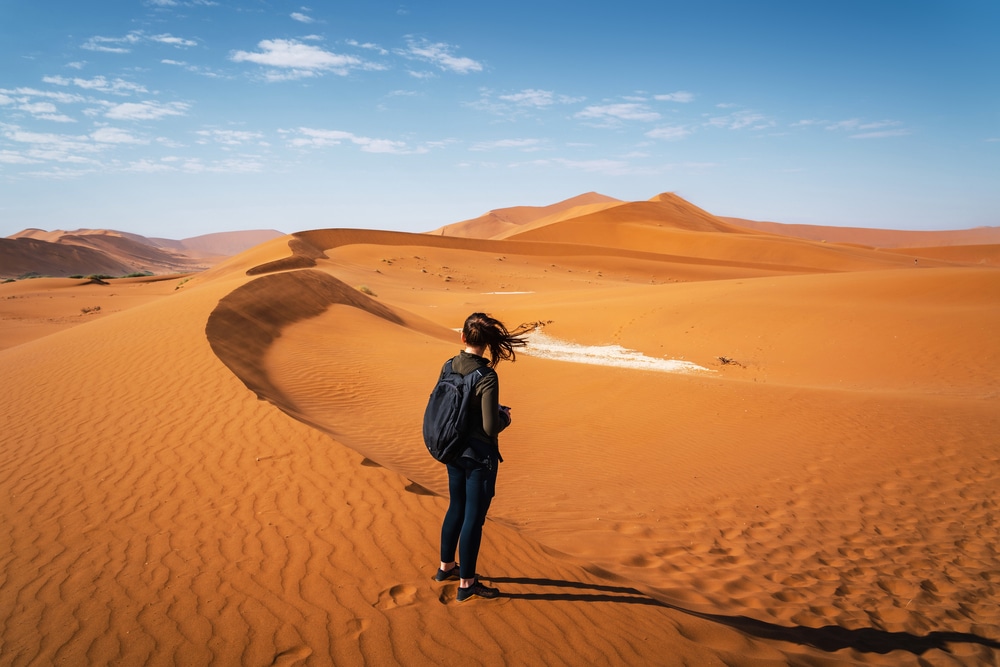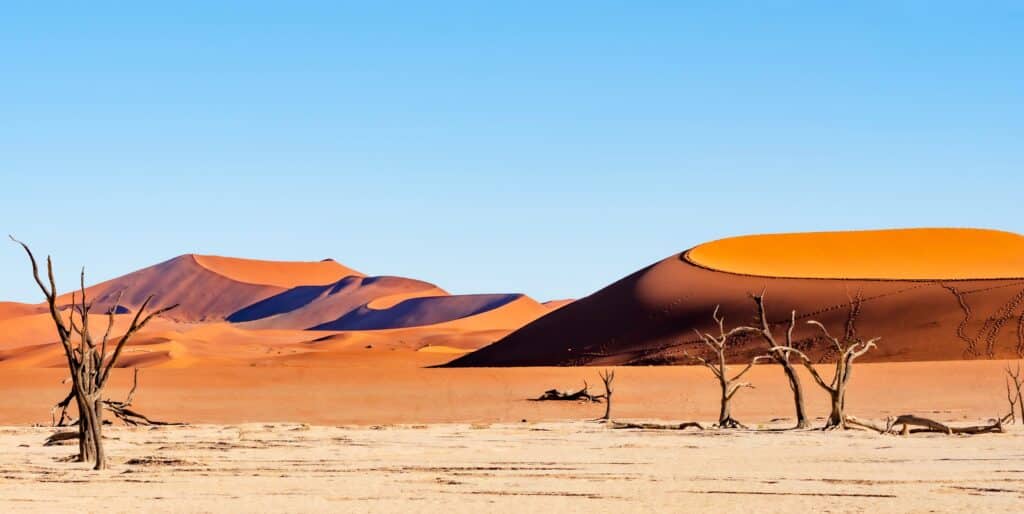
Striking Namibia – A Land of Open Space
Namibia is a country situated on the southwestern coast of Africa and is often called South West Africa. Its primary neighbours are Angola (to the north), Botswana (to the east) and South Africa (on the south-south-easter end). On its west side is the Atlantic Ocean. Many split Namibia (horizontally) into three primary topographic zones, which are the coastal Namib desert, the Central Plateau and then Kalahari. The name Namibia means ‘the land of open spaces’.
The coastal areas are somewhat cooled and currents carry an abundance of fish. However, it’s estimated that less than 1% of this country is considered to be arable (suitable for growing crops), although about two thirds is fine for raising animal herds.
Approximately 85% of this country’s people are Black, with 5% being of European heritage and about 10% being South African colour. The majority of people are Ovambo, with Kavango, Herero and Damara and Caprivian making up most of the balance.
Whist English is the ‘national language’ it’s only spoken by a small number (around 3%). 80% of people speak Ovambo. Around 85% of the people are Christians; with about 50% being Protestant and 20% being Roman Catholics. It has strongly been influenced by the Dutch and German colonists and hence why its capital is Windhoek which is an Afrikaan word, meaning ‘windy corner’.
What is most striking about Namibia is the striking contrast of bright rusted orange sands versus a cobalt clear blue sky. In fact, this country’s clear and unpolluted skies make it a premium stop for stargazers and astronomers.
This country has a strong dedication to conservation, with many areas geared towards the protection of its natural habitat. There are a number of conservation parks. In 2013 Namibia was the recipient of the ‘Gift to the Earth’ Award from WWF (World Wildlife Fund).
Animals in this country include the Springbok antelope, cheetahs, meerkats, aardvarks, wildebeest, Great Kahu antelope, rare white rhinos, honey badgers, wild dogs, hyenas, impala, warthogs, brown fur seal, desert rain frogs, vultures, scorpions and more. Actually, Namibia is known to have the largest population in the world of free-roaming cheetahs.
Both sunrises and sunsets are spectacular here. The varied desert landscape is beautiful, animals are often seen naturally after sunset, with no pollution and less lights than we often have in Australia, the endless stars are beyond incredible.
The Namib Desert is said to be the oldest desert and its population (people and animals) have well learned to adapt to an environment that most of us wouldn’t cope in without assistance. What is incredible is that after rain, the copper orange desert becomes a spread of magnificent colour. Blooms, in pinks, purples, yellows, whites and oranges, suddenly appear and make the desert a spectacular show of colour and beauty. What a wonder are fields of Sandhof lilies that appear after rare large amounts of rainfall, where there are often pools of water. It’s not often seen and is quite rare, so check out these images by an international photographer at: https://blog.tracks4africa.co.za/sandhof-lilies-a-must-see-natural-wonder/.
Summer in Namibia is like ours, December to February and it can get quite hot at times. But it’s a dry heat, unlike areas of Australia, especially Queensland where it can be quite humid. Winter is a very mild and pleasant 25 degrees during the day. Naturally with a climate like this, you’ll want to dress light in cool, breathing fabrics. Remember also, with wildlife, it’s highly recommended to wear natural earthtone colours; you don’t want to be a bright ‘red flag to a bull’.
There are a range of various things to do and see in Namibia, including:
- Desert dune rides are popular, or simply take an evening desert walk, where you’ll see things from quite a different perspective.
- If you’re looking for another different perspective, then consider a hot air balloon ride. Here you’ll truly experience the colours, beauty and vastness of this country in its full splendor.
- If you’re feeling a little energetic, then climb the world famous ‘Dune 45’. This is the only dune in the Sossusvlei area, which is open to the public for climbing. No others are, purely to limit the impact from too many tourists. Dune 45 stands 170 m tall and is relatively easy; taking the average person around 45-60 minutes to do. It is, however recommended you avoid the heat of the day and do this at sunrise and of course take lots of photos!
- Visit the Cheetah Conservation Fund (CCF) Research & Training Centre, located outside Ojiwarongo. Here you’ll both see cheetahs and learn more about them and learn more about this fund, which was started in 1990 to help with the protection and conservation of this species.
- If you happen to be in Namibia’s capital in April, visit the Windhoek Karneval (WIKA for short). This annual extravaganza brings the spirit of carnival, cultural festivities and a celebration of traditions to the heart of Namibia’s capital. Last year in 2024 they had their 70th festival. There are street parades, events, fun competitions, food and much fun. It can be considered a little akin to Germany’s Oktoberfest.
- Incidentally, due to the cultural German background here, Oktoberfest in Namibia is a very lively and well celebrated event – with much beer, food and music occurring.
- Again, if feeling like a little exercise, then hike the Rish River Canyon. This is second only to America’s Grand Canyon. The Fish River Canyon is the second largest in the world (both in size and length) … but it’s spectacular. It hasn’t quite got the brilliance of colours as the Arizona Grand Canyon, but not too far behind it. You’re probably wondering where it got its name? No, it’s not shaped like a fish. Rather the Great Fish River flows through it and the local Khoekhoe people call it ‘Oub’ which in English, means ‘fish’.
So, as you can see, there are a tonne of different things you can do in Namibia, from viewing incredible orange sand dunes, with a deep cobalt blue sky as a backdrop, to sunrise walks and sunset sights. You can ride a balloon, or take a guided horse ride. Visit museums, local communities and a range of nature reserves where you’ll see many wildlife animals. Shifting dunes, long dead ship carcasses, or at the other extreme, magnificent wildflowers that bloom after the rain. Take a quad bike ride into their Fish Canyon, or visit the Kolmanskop Ghost Town. This was a place which was a diamond mine some time ago, but today, we don’t think you’ll be finding any diamonds – sorry!
As with all our tours, we organise everything for you, and of course, it’s in luxury. You’ll be travelling with like-minded ladies, so if you don’t have a travel buddy, don’t worry, that won’t last long. Some travel friends often do future trips together as strong friendships are built. So all you need to do is pack a great camera or ensure your phone has a good quality camera on it, and you’ve tonnes of space on it – you’ll be wanting to take a heap of Insta-worthy shots your friends and family will be envious about. If you are interested in this trip, or any of our other trips, just reach out to us at CONTACT US and we’d be happy to answer any questions. If something does interest you, reach out sooner rather than later, as we absolutely limit group sizes and spots can go rather quickly.
Check out our Namibia tour HERE
Our guests travel in style, are comfortable and have the joy of experiencing superbly curated locations with other like-minded ladies. Come on – join us. : )
